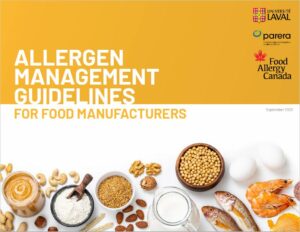In November 2022, Université Laval and Food Allergy Canada’s research paper, Allergen management under a voluntary PAL regulatory framework – a survey of Canadian food processors was published in Heliyon. This research focused on findings from a survey among 84 Canadian food and beverage manufacturers with the goal of understanding allergen management practices, including the use of precautionary allergen labelling (PAL), and getting industry input on areas for improvement.
Why this research matters

Food allergy affects approximately 3 million Canadians, and impacts 50% of Canadian households1. Over a 4-year timeframe, the number of emergency department visits for anaphylaxis has more than doubled2, with food being the main cause3. In order to make safe choices, consumers with food allergy need access to accurate ingredient information and depend on manufacturers to have proper allergen controls in place.
Today’s voluntary framework for PAL – impact on consumers and manufacturers
Currently, the use of PAL in Canada is voluntary. While Canadian regulations require food and beverage manufacturers to implement preventive controls to manage allergens and ensure their accurate declaration on the label, the use of PAL is left to the discretion of the food industry. This has led to variability in industry practices and consumer confusion in interpreting the label.
Understanding current PAL practices – what we learned
The research found that:

- Food and beverage manufacturers consider allergen management to be an important part of their overall food safety programs, with 92% of surveyed companies having a defined allergen management approach in place – which is most commonly integrated into an existing food safety program.
- 87% of respondents use priority allergens as ingredients and 67% of respondents label finished products with PAL.
- 94% of survey respondents agreed that minimum standards for allergen management should be required for all food and beverage manufacturers.
- Canadian manufacturers, specifically larger companies, may be adequately equipped to operate in a regulated environment, including the potential use of allergen thresholds.
Researchers also noted that incorporating risk assessment in PAL decisions, with or without allergen thresholds, would be a logical first step towards enhanced PAL regulation.
The path forward

The research highlighted the pressing need for greater guidance in the Canadian food manufacturing sector, particularly concerning allergen risk management and the use of PAL. This insight laid the groundwork for the creation of new Canadian guidelines tailored for the food industry.
Developed by industry experts, the Allergen Management Guidelines for Food Manufacturers adopt a risk-based approach to allergen management, offering crucial information and resources to assist Canadian food and beverage manufacturers in assessing and refining their allergen management practices.
References
- Clarke et al., 2020
- Hochstadter et al. JACI 2016;137(6):1888-1890.e4
- Lee et al., 2017; O’Keefe et al., 2017
